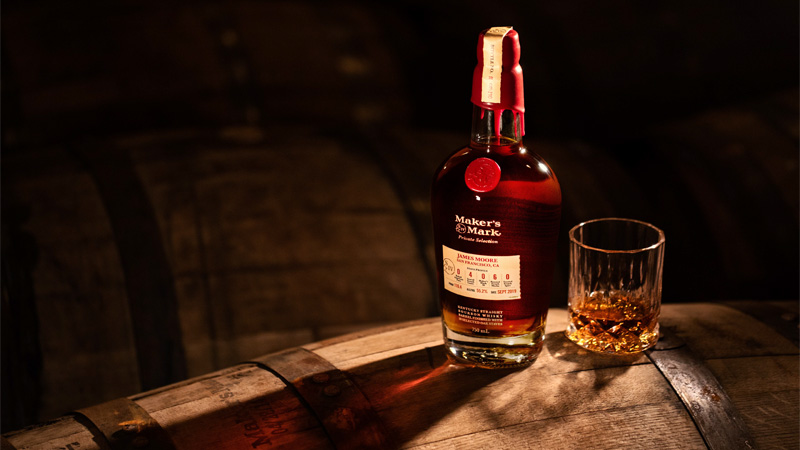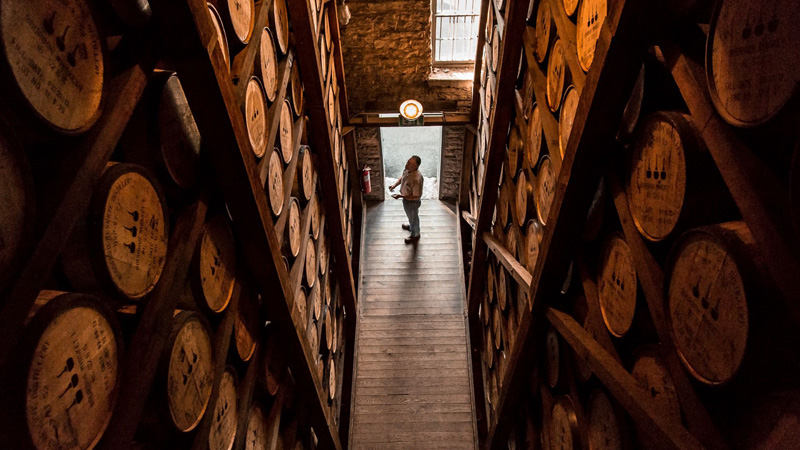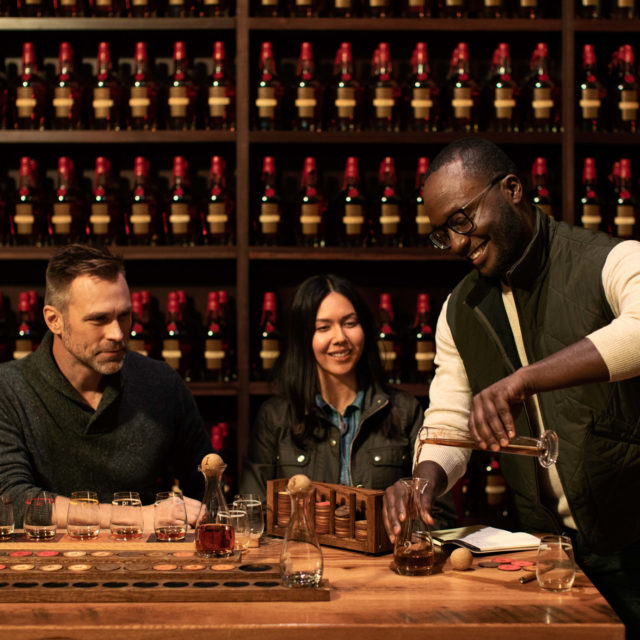On a recent Thursday afternoon, Woodford Reserve master distiller Chris Morris and assistant master distiller Elizabeth McCall buckled up for a three-hour WebEx meeting with the Ohio Liquor Control Commission. Over the course of the call, the group would taste dozens of bourbon samples and compile 10 custom blends to be sold in Ohio’s state-run liquor stores.
In pre-pandemic life, the tasting would have taken place at Woodford’s Versaille, Ky., distillery, following a hearty lunch and a private tour of the facility. Even without the incentive of a behind-the-ropes tour and a meal fit for royalty, interest in custom blends remains as high as it’s ever been, Morris says. “Almost a year in, we haven’t really seen a slowdown of our Personal Selection Program,” he adds. “It’s incredible.”

The continued demand for so-called “barrel picks,” where bars or retailers purchase all the bottles from a single cask and sell them as an exclusive offering, will hardly surprise those with an eye on whiskey trends. Though they’ve existed for multiple decades, only in recent years have private barrel selections crossed into the mainstream and become the most sought-after products for consumers and retailers alike.
“One of the reasons for the bourbon renaissance was the rise of single-barrel and small-batch whiskeys,” says Eric Gregory, president of the Kentucky Distillers’ Association. “[Barrel picks] fit in with that hand in glove.”
For distilleries, offering barrel picks is a shrewd business move and important means of building consumer relationships. For drinkers, they promise relatively affordable exclusivity — or as close as one can get — in an age of unicorn hunting.
Having taken part in more than 150 barrel-pick tastings, Blake Riber, founder of online craft spirits retailer Seelbach’s, is well placed to explain how the process works:
While single-barrel bourbons have been popular for decades, only in recent years have distilleries fully embraced the practice of letting their trade customers be the ones who select which barrels are bottled and sold without blending. Buyers for those barrels range from distributors and retailers and bar and restaurant owners to groups of average-Joe whiskey aficionados. Prior to Covid, buyers would head to a distillery to sample from those barrels and enjoy special perks like meals, tours, and tastings with high-ranking employees. (Much like most other aspects of life during the pandemic, now everything instead takes place online.)
Once the buyer decides on their favorite sample, they commit to purchasing the entire barrel. Sadly, no one gets to head home with the 200-liter American oak cask because of U.S. liquor laws, Riber explains. So the distillery bottles the entire barrel’s worth of whiskey for the buyer and adds a special label or tag to each bottle, commemorating the pick.
Remarkably, it’s likely barrel picks wouldn’t be quite so popular without that simple sticker. Retailers and bar owners can point to them and tell guests, “I had a hand in creating this product.” For consumers, it’s proof they’re holding on to one of only 200-or-so bottles in existence.
“The big draw for a lot of people is that unique factor,” says Riber. “It’s limited, it’s scarce, and it plays on all those things that the whiskey world loves.”
While whiskey’s collectible nature has driven sales and fueled overall interest in recent decades, the practice of selecting individual barrels to bottle is much older than most aficionados realize.

In the 1950s, during his time as president of Brown-Forman, the late George Garvin Brown II introduced a new Old Forester expression called President’s Choice. An early precursor to modern-day barrel picks, Garvin Brown II would hand-select standout barrels for the exclusive line, which remained part of the distillery’s portfolio until 1969, when the president unexpectedly passed away during a routine medical operation.
Woodford’s Morris says Brown-Forman (which also owns Woodford Reserve) later played an important role in the resurgence of barrel picks. In the late 1990s, the company began offering them in the modern-day guise of retailers and restaurants making selections from its Jack Daniels brand. Other distilleries soon followed suit when they realized just how keen certain hotels and retailers were to offer something their competitors didn’t have. The term is somewhat modern, but FOMO, it seems, is eternal.
In those days, master distillers such as the late Jimmy Bedford of Jack Daniels tasted samples with buyers at different accounts around the country. But distilleries soon realized it made more sense to bring the process to their properties. Their master distillers would no longer need to be on the road so often and — more importantly — it would allow them to roll out the red carpet and drum up even more excitement in the program.
“It was a great incentive because there weren’t that many distilleries back then,” Morris says. “Buyers were going to the big, historic distilleries and being treated like kings and queens.”
Even today, for restaurants and retailers, such an exclusive opportunity with distilleries is no doubt an essential draw of custom-barrel selections. Meanwhile, the distillery experience affords brands the chance to stand out from their competitors, especially now that all the major players offer some form of barrel picks.
Among them, Maker’s Mark’s barrel program is surely one of the most exclusive and involved experiences. During the course of their visits, buyers taste the distillery’s proprietary yeast, taste whiskey fresh off the still, and taste the influence of barrels, time, and maturation. The program then sees them not buy select barrels but create and fill their own.
Maker’s Mark has pioneered a stave-finishing process whereby cask-strength whiskey (usually around 6 and a half years old) finishes its aging period in a barrel with profile-altering staves. With five staves to choose from and 10 slots in the barrel, there are over 1,000 flavor combinations, explains chief operating officer Rob Samuels.
To determine the final composition of their barrel, groups are given 10-milliliter samples of whiskey finished with each stave, and then compile their potential blends. When they eventually settle upon a formula — major arguments are not uncommon, Samuels says — the whiskey rests for a final nine weeks before it’s bottled by the distillery and sent off to the waiting customer.
“Beyond a bespoke barrel and collection of bottles of whiskey that are uniquely your own,” Samuels says, “to have an experience that celebrates Kentucky culture, to have a moment in time with a close group of friends or family members, this experience … it’s hard to describe.”
Other distilleries offer incentives beyond barrel customization. Buyers of WhistlePig’s Reserve Barrel program can look forward to a stay at the Vermont distillery’s on-site farmhouse, which is decked out with a games room, two bars, a private chef, and enough rye whiskey to sink a ship.
Jeff Kozak, WhistlePig’s CEO, enjoys barrel picks from both a business and enthusiast’s perspective. Kozak describes them as the “purest expression of whiskey” and says they allow brands to trial experimental releases with very little risk.
If drinkers respond positively — feedback usually spreads pretty fast on Reddit forums — distilleries can then consider whether it’s viable to commercialize that particular offering. “It’s innovation on steroids,” Kozak says.
With barrels yielding up to 250 bottles, each pick becomes its own hyped, exclusive commodity. Often, a simple bottle label denoting such rarity is not enough for whiskey groups and societies — especially in today’s online landscape. So they instead turn to quasi-legal customization.
By law, bottles must reach their final destination bearing only the labels approved by the Alcohol and Tobacco Tax and Trade Bureau (TTB). But certain groups and retailers sell their picks with an additional personalized label, which consumers can attach to the bottles if they desire.
Kozak says not all brands enjoy this level of customization but he sees it as a sign of love for his brand. His favorite example to date came from Chicago grocery store GNS Market, which named its pick “Assistant To The Regional Boss Hogg” and designed a custom label featuring Dwight Schrute (of NBC’s “The Office” fame) with a pig snout.
https://www.instagram.com/p/CI8tJzFBgd1/
Seelbach’s Riber says barrel picks from Kentucky’s New Riff distillery, which are highly regarded within the whiskey community, have become a prime target for customization because of the appeal and potential for playing on the word “Riff.”
Standout examples include “Riffler’s Mom,” “Ken Riffey Jr.,” and the recent “SherRiff Woody,” whose creators dipped bottles in yellow wax, topped them with cowboy-hat stoppers, and attached a label that would be familiar to all as the outfit of the protagonist of the “Toy Story” movie franchise.
https://www.instagram.com/p/CJvoJT4MGeG/
“This stuff drives demand,” Riber says. “It really is like baseball cards at this point.”
As demand has grown, distilleries have cottoned on to the fact that the value of barrel picks extends beyond securing a few hundred bottle sales in one transaction. Access to barrel picks is now its own valuable commodity.
Bill Thomas, owner of Washington, D.C.’s legendary whiskey bar Jack Rose, has been buying barrel picks for the last 18 years. And while they had been widely accessible from most major distilleries during that time, Thomas says the accessibility — and the whiskey — is slowly drying up.
Where bar owners and retailers could previously simply call up a distillery, now producers take other factors into account before agreeing to sell customers a barrel pick. These factors range from the history of the relationship between brand and buyer to how many bottles a retailer sells of the distillery’s or parent company’s other products. “You have to earn your place in line,” Thomas says.
Thankfully for him, Thomas’s long-term experience and the notable reputation of his bar ensure he still gets access to barrel picks. “If it wasn’t for single-barrel picks,” he says, “I would have lost my excitement for the business years ago.”
This story is a part of VP Pro, our free platform and newsletter for drinks industry professionals, covering wine, beer, liquor, and beyond. Sign up for VP Pro now!
